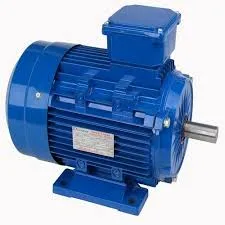What Is an Explosion-Proof Motor?There are two scenarios in which
an electric motor can cause an explosion:The surface temperature of
the electric motor increases due to heating that occurs to match
the ignition temperature of the flammable matter that has
accumulated in the factory or the industrial structure, causing a
spontaneous explosion.The electric motor sparks as a result of an
anomaly that causes an explosion within the casing. This explosion
becomes the catalyst that ignites the incendiary dust or liquid in
the factory, resulting in a bigger explosion.An electric motor is
considered explosion-proof when it is capable of containing an
internal explosion without rupturing and putting the entire
industrial facility at risk.Though the terms "explosion-proof
motor" and "hazardous location motor" are often used
interchangeably, there are key differences that become evident once
the divisions and classes of operating spaces are carefully
analyzed.Types of Hazardous Locations and Groups of Inflammable
MaterialsDivision: LocationDivision I - A Division I location is
hazardous even in normal conditions. Flammable particulate matter
or incendiary liquids are produced, and they accumulate as a result
of the execution of manufacturing processes.Division II - A
Division II location becomes hazardous in abnormal conditions. If
there is a rupture, burst, or leak resulting in spillage or seepage
of inflammable substances, then the area is considered a Division
II property.Class: LocationClass I - Class I locations contain
gases and vapors that are known to auto-ignite and cause
explosions. Gasoline and acetylene are common examples of such
vapors.Class II - Class II locations involve the presence of
flammable dust, like grain and coal, in the environment.Class III -
Class III locations involve the presence of flammable fibers, such
as textile and wood shavings.Groups: Type of Principal Flammable
AgentGroups A to D - Acetylene, hydrogen, ethylene, and acetone are
some of the gases and vapors that belong to these groups.Groups E
to G - Covering aluminum, coal, corn, and sugar, these groups only
pertain to flammable particulate matter.Classifications and
Standards for Hazardous Location Motors: A Five-Step Selection
GuideChoosing the right hazardous location motor can be a daunting
task. But the following guidelines can help users zero in on the
specific type of motor construction they need to ensure the safety
of their property and location.Identify the division and class of
your property. Local safety authorities can usually assist in this
process.If you are a Division I, Class I location, you need a
proper explosion-proof electric motor. It should be fully capable
of confining the effects of an internal explosion, as the slightest
exposure to sparks can auto-ignite the flammable vapors in the
atmosphere. Motors with tighter joints and longer flame paths cool
escaping flames, allowing them to be extinguished.If you are a
Division I, Class II location, it's a good idea to choose an
electric motor with a casing that keeps the surface relatively
cool. These motors have bearing dust seals.It is more important to
identify the class of your location, as opposed to the division. By
default, all Division I equipment will also serve Division II
requirements. Motors that serve Division II locations are generally
referred to as hazardous location motors - motors that can handle
anomalous hazardous situations.UL is the only safety agency
recognized for the approval of motors in hazardous locations.
However, this body doesn't offer any evaluation standards
for:Motors that can run in Division I, Class I, Groups A and B
locationsMotors that run in Division II locationsMotors that run in
Class III locationsA vendor claiming UL approval for such equipment
shouldn't be trusted.The Importance of Motor ClassificationsKnowing
the division, class, and group of your property is crucial for
ensuring you choose a well-suited motor that will improve
productivity without introducing the danger of explosions.
Likewise, fully understanding the hazardous location and
explosion-proof motor standards will greatly reduce the risk of
accidents and injuries.More cautious users may also explore the
auto-ignition temperatures of their flammables and put in place
cooling systems or ventilation machines, which keep heating in
check and prevent the buildup of incendiary material in enclosed
spaces.nduction furnace is used for smelting or insulating ferrous
metals, non-ferrous metals, sponge iron, such as scrap iron, scrap
steel, copper, aluminum and so on. Complete working equipment such
as continuous casting machine, rolling mill, mainly used for the
production of billet, steel bar, angle steel, H-beam, I-beam, etc.
Using KGPS, IGBT, single or double power supply technology, PLC
(Siemens) can be realized throughout the monitoring.
Main supply list: 2 sets of electric furnace
body, 2 sets of hydraulic or mechanical tilting electric furnace
mecha
Related products about 185kw to 2500kw Eplosion Proof AC Motor
-
 Waste Tyre Plastic Recycling Machinery Machine Tire Crusher Production Line Rubber Crumb Grinding Machine Equipment Tire Shredder
Waste Tyre Plastic Recycling Machinery Machine Tire Crusher Production Line Rubber Crumb Grinding Machine Equipment Tire Shredder
-
 Stretch Plastic Blowing Pet Bottle Making Blow Molding Machine Bottles Stretch Automatic Pet Bottle Blowing Machine
Stretch Plastic Blowing Pet Bottle Making Blow Molding Machine Bottles Stretch Automatic Pet Bottle Blowing Machine
-
 Waste Plastic Pet Bottle, Water Bottle Flake, PP/HDPE/LDPE PE Film Jumbo Woven Bags Plastic Crusher Machine, Plastic Crushing Washing Recycling Machine
Waste Plastic Pet Bottle, Water Bottle Flake, PP/HDPE/LDPE PE Film Jumbo Woven Bags Plastic Crusher Machine, Plastic Crushing Washing Recycling Machine
-
 Type 2 Wall-Mounted Electric Car Charging Station 7kw /11 Kwelectric Vehicle Charging Station Home Wallbox AC EV Charger Single Phase or 3three Phase
Type 2 Wall-Mounted Electric Car Charging Station 7kw /11 Kwelectric Vehicle Charging Station Home Wallbox AC EV Charger Single Phase or 3three Phase
-
 G-View G12W Wholesale Auto Car LED Headlight Bulb High Power H13 H11 9005 H7 H4 Car LED Headlights LED Car Lights
G-View G12W Wholesale Auto Car LED Headlight Bulb High Power H13 H11 9005 H7 H4 Car LED Headlights LED Car Lights
-
 New Design Porcelain Round Plates Dinner Set for Wedding and Banquet
New Design Porcelain Round Plates Dinner Set for Wedding and Banquet
-
 China 2023 New Design Super Soft 100% Polyester Microfiber Knitted Oversized Decoration Hoodie Blanket
China 2023 New Design Super Soft 100% Polyester Microfiber Knitted Oversized Decoration Hoodie Blanket
-
 Handmade Art Creative Materials Thickened White Paper Cup DIY Disposable Handmade Colored Paper Cup
Handmade Art Creative Materials Thickened White Paper Cup DIY Disposable Handmade Colored Paper Cup






